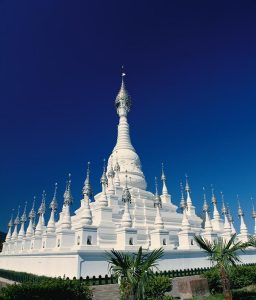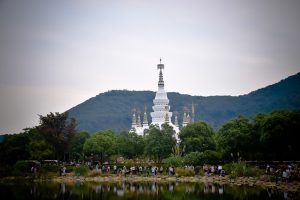
Manfeilong Pagoda in Jinghong, Xishuangbanna
Xishuangbanna Manfeilong Pagoda in Jinghong City travel guide introduces the main attractions, entrance tickets booking, The best time to visit, How to Get there, the highlights, facts, history, photos, weather, accommodation, visiting routes, travel tips, tour maps of Manfeilong Pagoda in Xishuangbanna(曼飞龙白塔). Manfeilong Pagoda is located on top of the mountain in Manfeilong Village in Jinhong County of Yunnan Province. The pagoda is a famous stupa group in Xishuanbanna.
● Chinese Name: 曼飞龙白塔
● Keywords: Pagoda, Relic, Buddism,Dai ethnic minority,bamboo shoots,stupa
● Location: Manfeilong village, Jinghong City, Yunnan Province
● Scenic Area: Xishuangbanna Manfeilong Pagoda
● Admission Fee: 50 RMB for ticket and 40 RMB for shuttle bus
● Opening Hours:8:00~17:00
‣ About Manfeilong Pagoda
Crossing a river along Manfeilong Village, you´ll come across more than 200 stone steps, which have a boundless virgin forest on the left side and an exuberant hurst of rubber plants on the right side. The pagoda, on a mountaintop, actually consists of 9 stupas, with the primary stupa in the center while the other 8 smaller stupas clustering to its base. The primary pagoda measures 16.29 meters and the 8 pagodas on the sides look like a group of children nestling around the mother. In each stupa, there is a niche featuring a Buddhist statue and a Buddhist relief, and on top of the niche is a flying phoenix. At the gate of each stupa are two giant dragons engraved out of earth. Bells hung on the stupas give wonderful tinkles in the breezes.
Below one of the stupas and in a niche the Buddha´s footprint is enshrined. Legend has it that the 80 cm long and 58 cm wide footprint was left by Sakyamuni, the founder of the Buddhist religion, during his visit in the area.
Records in a sutra show that Manfeilong Pagoda was first built in 1204 (565 in the Dai calendar). It was designed by three monks from India and the design was executed under the sponsorship of the chieftain of Menglong tribe. After two renovates in modern times, the pagoda was listed as a national key cultural relic preservation site.

‣ About History
The White Feilong Pagodas was built in 1204 with a history of 778 years. It is said the pagodas were designed by three Indian Buddhist monks. The person taking charge of the construction was Hubananpi. All these are recorded in the Pattra Scripture.In the past few years, the pagodas have been restored and become the state historic relic reservation. During the Water-Sprinkling Festival, the Dai people, men and women, old and young, will dance around the pagodas to cerebrate the New Year.
‣ About Features
Manfeilong Pagodas, also known as the Flying Dragon White Pagodas. It is also known by two other names: White Pagoda and Bamboo Shoot Pagoda. Built with stones and bricks in 556 by the Dai calendar (1204), the pagodas are octangular in shape.
On the primary rock appears a foot print, which is said to be made by Sakyamuni. The Manfeilong Tower Pagoda consists of nine stupas. They are made of bricks, with typical club-like bases topped by calabash shaped bodies.
Seen from the distance, they look very like bamboo shoots that have emerged from the soil after the spring rain. The Manfeilong Pagoda is decorated with beautiful sculpture, relief and colored paintings in the style of the Dai ethnic minority.

‣ Attraction Transportation
You can take the bus from Jinghong city to Damenglong. Buses run every 30 minutes. The ticket fee is 11 rmb.
‣ Best Time to Visit
October to April is the best time to visit Manfeilong Pagoda.
● The Manfeilong Pagoda is open all year round. As it is an outdoor area, it is better to avoid rainy days. You are recommended to check the weather forecast before setting out.
● The Water-Sprinkling Festival, the Dai people, men and women, old and young, will dance around the pagodas to cerebrate the New Year, is usually celebrated in the middle of April, lasting 3 to 7 days.
● Try to avoid Chinese public holidays, such as Labor Day (May 1st to 3rd) and National Day (October 1st to 7th). It is recommended that you start your day early so as to avoid crowds.

 7 Days GolfingTour
7 Days GolfingTour
 8 Days Group Tour
8 Days Group Tour
 8 Days Yunnan Tour
8 Days Yunnan Tour
 7 Days Shangri La Hiking
7 Days Shangri La Hiking
 11 Days Yunnan Tour
11 Days Yunnan Tour
 6 Days Yuanyang Terraces
6 Days Yuanyang Terraces
 11 Days Yunnan Tour
11 Days Yunnan Tour
 8 Days South Yunnan
8 Days South Yunnan
 7 Days Tea Tour
7 Days Tea Tour
 8 Days Muslim Tour
8 Days Muslim Tour
 12 Days Self-Driving
12 Days Self-Driving
 4 Days Haba Climbing
4 Days Haba Climbing
 Tiger Leaping Gorge
Tiger Leaping Gorge
 Stone Forest
Stone Forest
 Yunnan-Tibet
Yunnan-Tibet
 Hani Rice Terraces
Hani Rice Terraces
 Kunming
Kunming
 Lijiang
Lijiang
 Shangri-la
Shangri-la
 Dali
Dali
 XishuangBanna
XishuangBanna
 Honghe
Honghe
 Kunming
Kunming
 Lijiang
Lijiang
 Shangri-la
Shangri-la
 Yuanyang Rice Terraces
Yuanyang Rice Terraces
 Nujiang
Nujiang
 XishuangBanna
XishuangBanna
 Spring City Golf
Spring City Golf
 Snow Mountain Golf
Snow Mountain Golf
 Stone Mountain Golf
Stone Mountain Golf

















